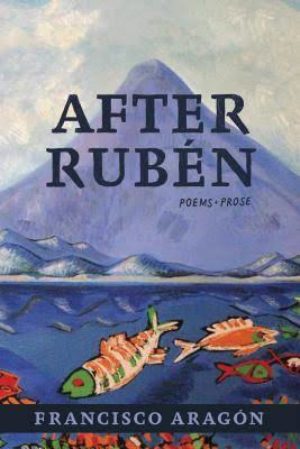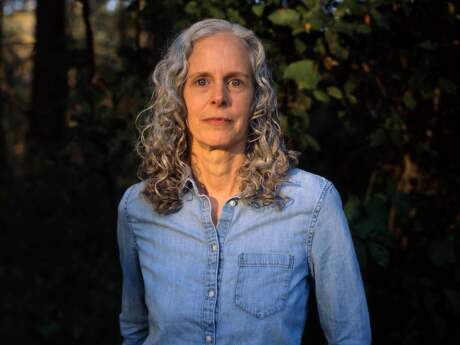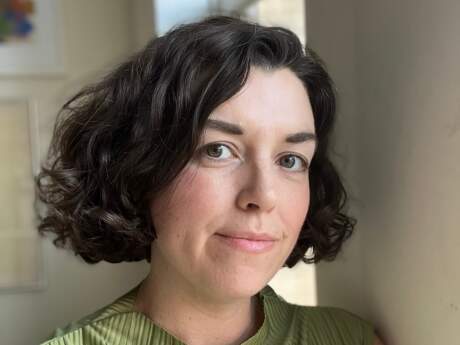In Their Own Words
Francisco Aragón on “1985”

1985
Long and black, the streaks
of gray, aflutter in the light
wind as she prepares to tell
her story at the Federal Building:
reaching into a tattered sack
she pulls out a doll
missing an eye, balding—
singed face smudged with soot
from the smoke her home took in
as her village was being shelled.
Next she retrieves what’s left
of a book—a few pages
the borders brown, coming
apart in her hands: hesitant,
she raises one, starts to read aloud:
por la mañana sube el sol y calienta el día
la tierra nos da dónde vivir y qué comer
la vaca nos da leche para beber y hacer mantequilla
It’s her daughter’s lesson
the poem she read to her
the day they struck—
(in the morning the sun rises and warms the day
the earth provides a place to live and what to eat
the cow gives us milk to drink and churn butter with...)
...mid-way through, her voice begins
to shake—her words
like refugees exposed to the night shiver,
freeze: silence
swallows us all...
...her words, drifting
casualities,
gather and huddle
in my throat.
San Francisco
From After Rubén (Red Hen Press, 2020). Reprinted with the permission of the author.
On "1985"
The poem is about the Reagan Administration’s Contra war against Nicaragua—the terror inflicted on communities there in the 1980s, including the woman portrayed here, her hair “[l]ong and black, the streaks of gray, aflutter in the light / wind as she prepares to tell // her story…” The earliest version of this piece, which I titled “Witness,” I presented in my very first creative writing workshop—led by Ishmael Reed. In its first iteration, the Spanish-language passage was, literally, a footnote.
And then I showed the poem to John Montague. He was a visiting writer on the Berkeley campus in the Fall of 1985. His snippet of wisdom I carry with me to this day. “Move the Spanish into the body of the poem,” he said. “You have two weapons. Use them both.” Montague was the first Irish poet whose work I fell in love with.
In 1987, “Witness” won Mr. Cogito’s Human Rights Poetry Contest, Mr. Cogito
being the name of a local literary journal. Another teacher, the Canadian poet Peter Dale Scott, had explained the magazine’s namesake to me. Here’s how the Wikipedia entry begins:
“Mr. Cogito is a character created by Zbigniew Herbert, a Polish poet and essayist. He first appears in a poem entitled "The Envoy of Mr. Cogito" ("Przesłanie Pana Cogito") published in 1973. Initially Mr. Cogito was an Everyman, a universal element of humanity sharing his opinions on various aspects of life and existence. However, the more he says, the more disembodied he appears, and becomes transformed into an ethical symbol and a metaphor of the tough choices we have to make between good and evil.”
I’d learned about the contest in Poetry Flash, a beloved Bay Area institution that was a touchstone during my formative Bay Area years. Joyce Jenkins, Poetry Flash’s founder and editor, was kind enough to reprint “Witness” after it appeared in Mr. Cogito. The poem was organized into stanzas of varying lengths, like paragraphs. Tercets were nowhere to be seen.
I graduated from college, moved to Spain, returned to California a decade later. It was during my time at UC Davis (1998-2000) that I learned about, was invited to submit to the anthology, Under the Fifth Sun: Latino Literature from California (Heyday Books, 2002). Among the poems I sent for consideration was “Witness”—but not before putting it through a more substantive revision. “Witness” became “Her Hair.” But I also re-visioned the stanzas, experimenting to see what kind of line and stanza breaks would result. I tried couplets. I tried tercets. I tried quatrains. In the end, I settled on stanzas that each had three lines, which produced, for example, this break:
her story at the Federal Building:
reaching into a tattered sack
she pulls out a doll
missing an eye, balding—
singed face smudged with soot
from the smoke her home took in
But “Her Hair” didn’t make it into my first book (2005), nor my second (2010). Which reminds me of a poem I heard Sharon Olds read on the Berkeley campus when I was a student there, a piece she designated as “new.” Towards the end, the speaker is racing through an airport to catch a plane to get to her father’s bedside before he dies. Olds had just published her third book, The Gold Cell (1987). I remember assuming that the poem would appear in her very next book. It didn’t. It wasn’t until The Father
(1992) that the poem in question appeared in a book. I remember making a mental note: oh, poems don’t necessarily appear in successive books in the order in which they are composed! And so “Her Hair” went bookless for years and years.
When it finally came time to assemble the manuscript that would become After Rubén (2020), I gave “Her Hair” yet another
look. It underwent two further revisions. First, I decided that “Her Hair,” as a title, didn’t really enhance the poem much beyond being a bland descriptor. Because so much time had elapsed, I decided I wanted to give the poem what I’ll call a more “historical” patina. I’ve often associated the 1980s with the Reagan years. That, coupled with the height of the Contra war, including the Iran-Contra affair, prompted me to simply anchor the poem as a year: “1985.” And then I went through the text and made the following final tweak.
from the smoke her hut took in
became
from the smoke her home took in
I’d decided there was something off—not quite right, presumptuous even, about “hut.” This final edit took place in 2018.
One final tidbit: in the summer of 1985 I found myself, one afternoon, at a protest rally on the steps of the Federal Building in San Francisco. Speaker after speaker took to the mic, including people who had spent time in Nicaragua. One organization, Witness for Peace, was particularly active in those years. At the gathering, a man who’d worked with this organization stepped to the mic and told the story of a woman whose young daughter had been killed in northern Nicaragua when the Contras attacked her village. He was holding “a tattered sack” that belonged to the woman. She’d told him her story and asked him to share it with anyone who would listen. In the middle of his testimonio he broke down and began to sob. The man’s name was Daniel Ellsberg—of “Pentagon Papers” fame. The story, his telling of that woman’s story and the death of her daughter, clearly impacted him—deeply impacted me.
When the impulse to attempt a poem took hold of me, I had a decision to make. Do I render Daniel Ellsberg the protagonist, thereby remaining accurate about the incident that produced my emotional response? Or do I take an imaginative leap and find another way to get at the emotional truth of the story—that is: the woman and her daughter, and not Ellsberg? I decided on the latter. Nevertheless, Ellsberg, by holding up the “tattered sack” and retrieving from it the disfigured “doll // missing an eye, balding— / singed face smudged with soot” (these details were true), provided one of the key images of the poem—a poem that, in essence, took thirty years to complete.



